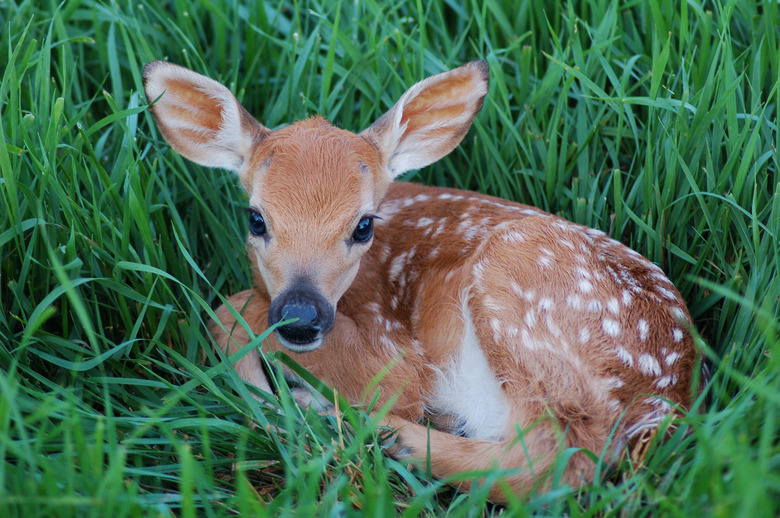How To Tell A Fawn's Age
White-tailed deer comprise the greatest distribution of large mammals in North America. They gain their name from the iconic white fur on their tails. Their fawns undergo physical and behavioral changes as they grow older, and their age can be determined by observing these characteristics. Discerning fawn age helps provide data for herd condition and management.
TL;DR (Too Long; Didn't Read)
The age of white-tailed deer fawns can be determined in a number of ways. Coat color, size, foraging behavior, play, antler formation and teeth eruption are all clues to the age of a fawn. Remember not to disturb newborn fawns.
Newborn Fawns
Newborn Fawns
When the mother doe gives birth in the spring, her fawn or fawns wear ruddy-brown fur. The fur bears white spots, mottled here and there on a fawn's back, mimicking shafts of light and shadow among trees. This fur protects the fawn from the eyes of predators and passers-by as camouflage. Newborns bear little to no scent prior to scent-gland development. They weigh between 6 to 8 pounds when born. The newborn buck fawns weigh slightly more on average than newborn doe fawns. These young fawns lie hidden among vegetation while their mother forages for food, and when she returns they nurse four times a day until they reach four months old.
Newborns can move about even on their first day. Typically, however, fawns will not venture forth to graze until they reach between two weeks and a month old. While the mother leaves her fawns alone for periods of time, these baby deer rest safely and should not be disturbed. The mother never ventures far afield, and she will move her fawn when she returns. The spots on the fawns begin to fade at around three to four months old. Fawns wean by the end of summer.
Six-Month-Old Fawns
Six-Month-Old Fawns
By the time fawns reach roughly six months old, they participate more socially. They play and exhibit great curiosity, and tend to be less wary than adults. More aggressive buck fawns tend to enter clearings first. These fawns possess shorter snouts than adults. The bodies of fawns at this age are short and square-shaped when compared to adult does. By winter, fawns will weigh between 60 and 70 pounds and show no spots. Their coats change according to season.
Older Female Fawn Traits
Older Female Fawn Traits
Because does primarily form white-tailed deer social groups, female fawns tend to stay with their mothers longer than male fawns. At three and a half years, does reach maturity. Doe fawns as young as six months old can breed and give birth at one year of age. Does reach full maturity at around three-and-a-half years.
Older Male Fawn Traits
Older Male Fawn Traits
Male fawns grow "buttons" or pedicles where antlers will erupt. Male fawn heads appear flattened. At approximately ten months old, antlers erupt. Once a male fawn becomes a yearling, the first antlers become "spikes." These yearlings resemble adult does except for their developing antlers and their lean legs. As the male grows into an adult buck, he will shed and regrow antlers as testosterone ebbs and flows for breeding seasons. Bucks reach maturity between five-and-a-half and six-and-a-half years of age.
Tooth Wear
Tooth Wear
For many years, wildlife managers have relied upon tooth wear to aid in white-tailed deer aging. Fawns less than a year old only have four or five erupted teeth. The third premolar has three cusps. At one and a half years, these young deer will have six teeth on their lower jawbone. As deer grow older, aging by teeth becomes more difficult. Their teeth lose enamel and their dentine material is revealed. Following tooth wear gives insight not only into fawn age but also herd health.
References
- Texas Parks and Wildlife: A Guide to Age Determination of White-Tailed Deer
- Pennsylvania Game Commission: White-Tailed Deer Wildlife Note
- The Connecticut Agricultural Experiment Station: White-Tailed Deer Fawn Fact Sheet
- University of Missouri Extension: Ecology and Management of White-Tailed Deer in Missouri
Cite This Article
MLA
Hermance, Dianne. "How To Tell A Fawn's Age" sciencing.com, https://www.sciencing.com/tell-fawns-age-8628657/. 7 May 2018.
APA
Hermance, Dianne. (2018, May 7). How To Tell A Fawn's Age. sciencing.com. Retrieved from https://www.sciencing.com/tell-fawns-age-8628657/
Chicago
Hermance, Dianne. How To Tell A Fawn's Age last modified March 24, 2022. https://www.sciencing.com/tell-fawns-age-8628657/
